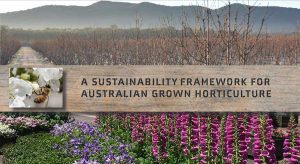
New research has identified the most important sustainability topics for people interested in Australian horticulture, from growers to consumers and communities. Topping the list are ethical and resilient practices, supporting healthy landscapes and meeting climate concerns.
The findings are included in the report What is important to Australian horticulture’s stakeholders?, the foundation for the development of the Horticulture Sustainability Framework. The framework will provide a tool to help the horticulture sector better communicate its sustainable, ethical and safe farming practice stories with stakeholders, from shoppers to investors.
“For the initial research, we investigated the topics that matter most to those involved in and interested in the sector,” Hort Innovation General Manager of Data & Extension Dr Anthony Kachenko said.
“This identified 21 important topics across six themes – ‘Vibrant, ethical, resilient businesses and employment’; ‘Nutritious, quality, safe food’; ‘Healthy landscapes’; ‘Thriving communities’; ‘Careful use of inputs’; and ‘Climate and energy’ – which the research showed are very similar to those identified by the horticulture sector itself. This provides huge potential for communication with these external stakeholders to develop a shared understanding of these topics and how they are being managed.
“They include ‘people’ based topics such as ethical labour and fair work conditions, ‘planet’ issues such as water use and the health of waterways, ‘produce’ factors such the production of safe, nutritious and high-quality food, and ‘performance’ areas such as protecting biodiversity and adapting to climate variability.
“Our Australian horticulture industries have said we need to commit to a sustainability journey. Our next step is to work with them to set sustainability goals and measures, both to demonstrate commitment to sustainability and to prioritise future actions.”
The Framework team is now beginning further work with horticulture’s peak industry bodies, growers and other participants to prioritise key aspects of the tool.
Access the report here.


